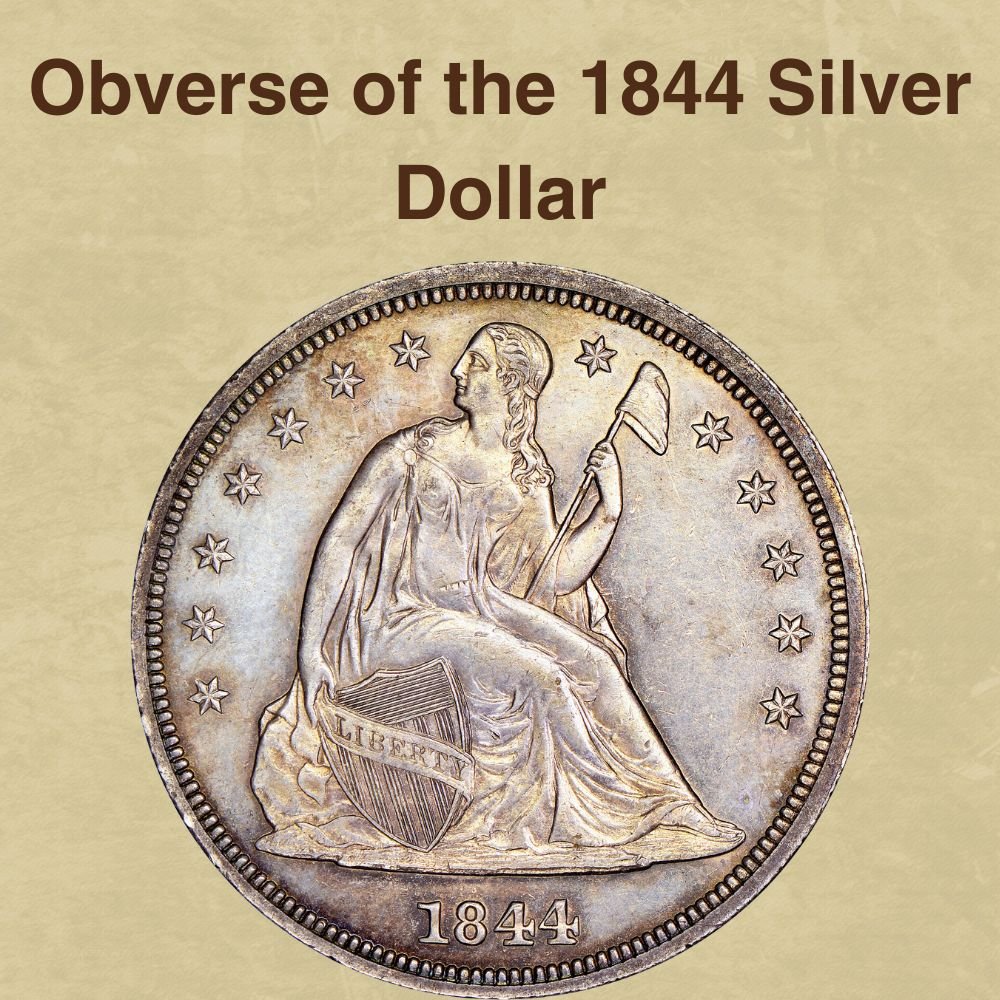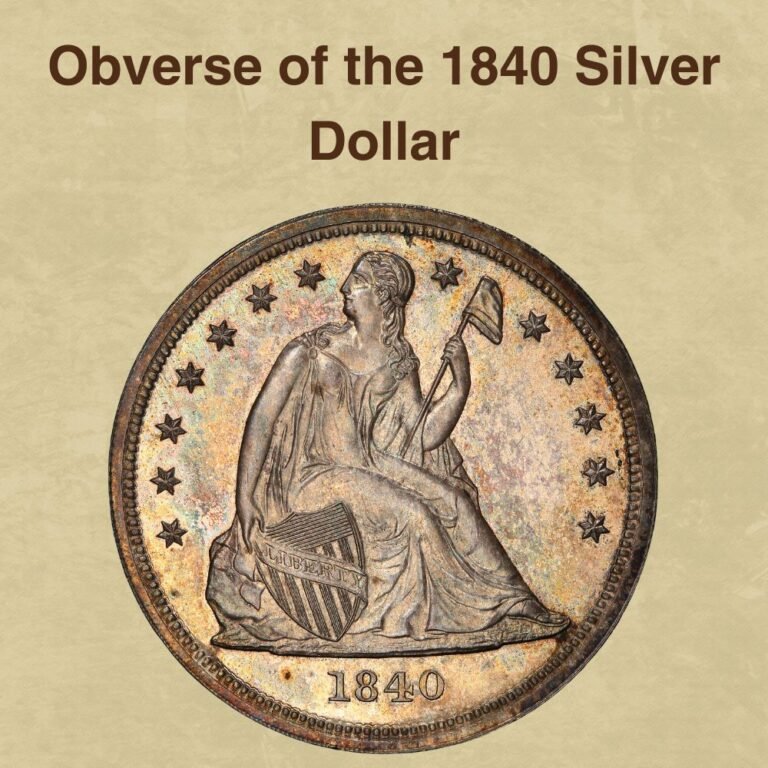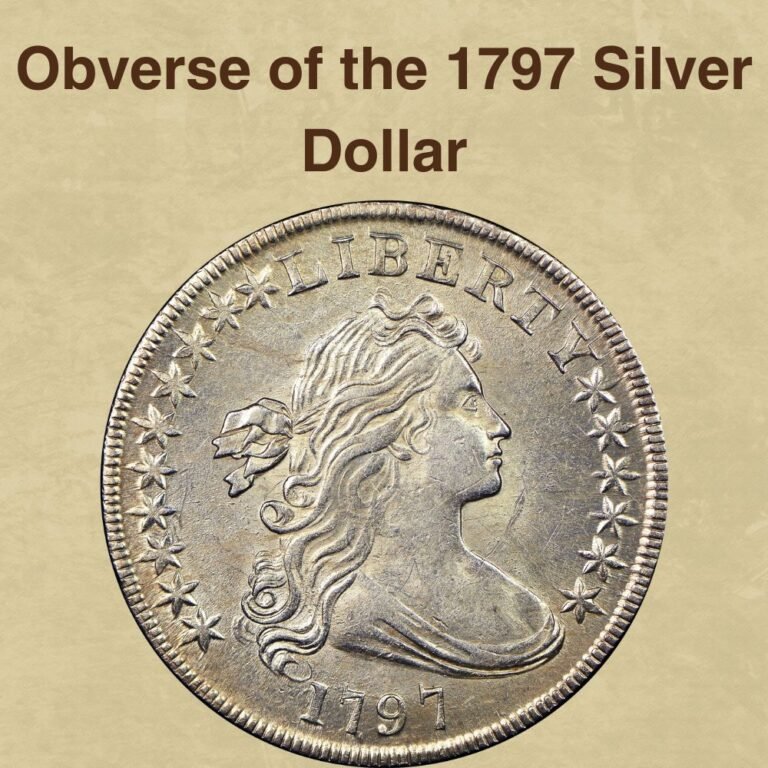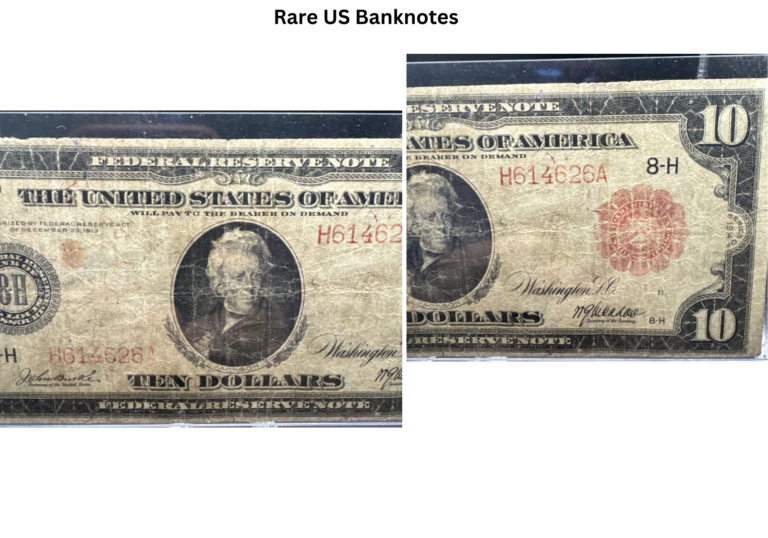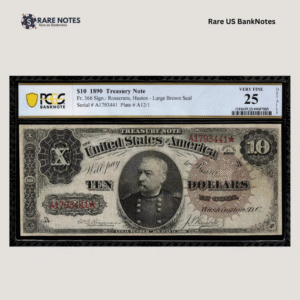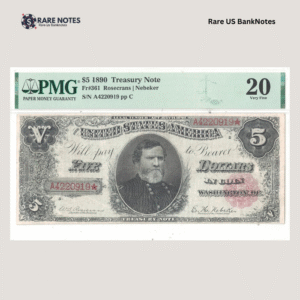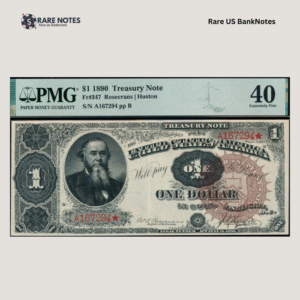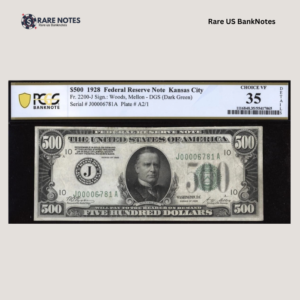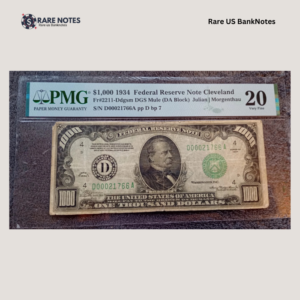If you are building a Seated Liberty dollar collection, you’re likely curious about the 1844 silver dollar value. With a historically low mintage, the 1844 silver dollar is every collector’s dream coin.
Want to learn more about this popular historic coin and why it’s a must-have for any serious collector? Our guide will help! We’ll reveal the real market value of the 1844 silver coin, how to authenticate and grade it, and also show you some interesting, high-value minting errors that are worth looking out for.
So, let’s jump in and find out: How much is a 1844 silver dollar worth?
1844 Seated Liberty Dollar Value Chart |
||||
| Mint Mark | Good | Fine | Extremely Fine | Uncirculated |
| 1844 Silver Dollar Value | $475 | $675 | $1,450 | $46,000 |
| 1844 Proof Silver Dollar Value | – | – | – | $85,000 |
History of the 1844 Silver Dollar
The 1844 silver dollar has one of the lowest mintages in the entire Seated Liberty dollar series, which the United States Mint struck from 1840 to 1873. The Seated Liberty design is based on the so-called Gobrecht dollar, an experimental coin that was used to gauge the public’s interest before a full-scale production of new silver dollars.
Preparations for new American coinage began in 1835, when the Mint Director, Robert M. Patterson, asked artists Thomas Sully and Titian Peale to sketch designs. Patterson proposed that the new design feature the image of Liberty seated on a rock holding a staff topped with a cap. The reverse, he suggested, should feature an eagle in flight.
Mint Chief Engraver William Kneass went to work to prepare patterns based on Patterson’s suggestions, but suffered a stroke and later passed on before the new silver coins were minted. The Mint hired Christian Gobrecht in 1835 as Kneass’s assistant, who, later in 1840, after Kneass’s passing, became the Chief Engraver.
Artist Sully sketched the new Patterson designs, which Gobrecht used to engrave copper plates for approval by the government before officially beginning the production of the trial strikes. After several modifications and strikes, what were known as the Gobrecht dollars were struck in December 1836. Production of small quantities of the Gobrecht dollars continued through to 1839, after which the minting process stopped.
In 1840, Patterson reviewed the design of the Gobrecht dollar and decided to replace the reverse design of the eagle in flight with a bald eagle inspired by a design by John Reich, a former engraver at the Mint. The obverse design was also modified by enlarging Liberty’s head, thickening her clothing, and lowering the relief. The new design also included thirteen stars.
Small quantities of the modified design were produced in July 1840 to familiarize bullion depositors with the new coins. The supply of silver deposits increased, allowing full-scale production later in the year. In November, the Mint delivered 41,000 silver dollars and an additional 7,505 in December. The Philadelphia Mint produced the new silver coins until 1846, after which a new Mint was set up in New Orleans to boost the production of American coinage.
It wasn’t long before silver bullion prices would increase significantly, and supply would decrease. This dynamic forced the Mint to immediately slow down on producing silver coins. As a result, starting in 1844, the mintage of silver dollars slowed significantly, and this trend continued into the late 1860s. However, in the final years of the Seated Liberty series, silver production peaked, which also saw the mintage increase.
In addition to being the first low-mintage year for the Seated Liberty dollar, the 1844 issue is also the only one with a significant doubled die on the obverse, which resulted in the shield having four small vertical lines inside the larger vertical stripes. All other Seated Liberty issues from 1840 to 1873 have only three lines. This uniqueness and its relative scarcity make the 1844 silver dollar a key date and a worthwhile addition to any classical coin collection.
Also read: 12 Most Valuable One-Dollar Coin Worth Money
Features of the 1844 Silver Dollar
Next, we’ll look at the physical attributes of the 1844 silver dollar, which can help to accurately authenticate and grade your silver coin, and even better, identify high-value Seated Liberty dollars worth collecting.
Here’s what to look out for:
Obverse of the 1844 Silver Dollar

On the obverse is an image of Liberty seated on a rock, looking over her shoulder, and dressed in flowy drapery. In her left hand, she holds a cane topped with a Phrygian cap, while in her right hand is a shield with the word LIBERTY inscribed diagonally.
Thirteen stars, seven to the left and six to the right, are positioned in an arc over Liberty’s portrait. The date, 1844, is inscribed at the bottom along the rim. The rim itself is decorated with small denticles.
Reverse of the 1844 Silver Dollar

The reverse features a left-facing bald eagle. A shield on its breast is symbolic of strength in the unity between the states under the authority of the federal government.
In its left talon, the eagle holds arrows, representing victory but also a readiness to defend the nation against any aggression. The olive branch in the right talon is symbolic of peace.
UNITED STATES OF AMERICA is inscribed in an arc above the eagle and along the rim, while the denomination, initialized as ONE DOL., is etched at the bottom. Like the obverse, the reverse spots small denticles around the rim.
Other Features of the 1844 Silver Dollar
Additional features of the 1844 silver dollar include:
- Diameter: 38.10 millimeters
- Weight: 26.73 grams
- Edge: Reeded
- Metal Composition: 90% Silver, 10% Copper
- Fineness: 0.9
- ASW: 0.7734oz
Also read: 14 Most Valuable Coins In Circulation
1844 Silver Dollar Value Guides
So, how much is a 1844 silver dollar worth? The market value depends on factors such as the coin’s condition and rarity. Minting errors can also significantly raise the value of your silver dollar.
We’ll look at two types of the 1844 Seated Liberty dollar:
- 1844 Silver Dollar
- 1844-Proof Silver Dollar
Let’s find out how much each is worth:
1844 Silver Dollar Value

The year 1844 marked the beginning of a low mintage streak for the Seated Liberty dollar. Only 20,000 pieces were struck at the Philadelphia Mint that year, a dramatic drop from the previous year’s mintage of 165,000 silver dollars.
Let’s break down the value of circulated and uncirculated 1844 silver dollars:
Circulated Examples: Despite the low mintage, circulated examples of the 1844 silver dollars are not as scarce as one might expect. This might have something to do with bank tellers and merchants picking out the 1844 silver coins out of circulation in the 1890s after realizing how scarce this particular issue was. This has made it possible for the 1844 silver dollars to regularly appear on the market.
Even in lower grades, survivors command comparatively high prices. For example, pieces graded Poor/Average can sell for as much as $375, and those in Good (G) condition can fetch up to $475. Fine examples are worth about $675, while the relatively scarce examples graded Extremely Fine (XF) can sell for at least $1,450. About Uncirculated are the most desirable of the worn examples, but prices can be a bit prohibitive for the new collector, with values rising as high as $4,500.
Mint State Examples: Uncirculated examples are also not as difficult to find as the low mintage might suggest. However, any examples graded higher than MS63 are an extreme rarity, and only one Gem survivor has been discovered to date. Due to limited die use, 1844 silver dollars in Mint State usually display satiny, shiny proof-like fields and often command significant premiums. In MS60, examples can fetch as much as $5,300 and up to $8,500 in MS62. Rare specimens graded MS64 can command $46,000 or more.
Auction Record: In a record sale, Legend Rare Coin Auctions sold an extremely rare MS64 for a staggering $47,000, making this one of the most valuable examples of the 1844 Seated Liberty dollar.
1844-Proof Silver Dollar Value

The 1844 silver proof dollars minted in Philadelphia are extremely rare. According to numismatic records, only about 15 pieces may have been initially minted, but fewer than 10 survivors have been discovered to date.
The finest example was part of the Eliasberg Coin Collection, and the majority of the known survivors are brilliant proofs. Some are graded as Cameos, but these are extremely hard to find. There are no known Deep Cameo survivors of the 1844 proof silver dollar.
Here’s what to expect when collecting these specimens:
- Regular Proofs: These command significant premiums right from the start. For instance, examples graded PF60 can fetch as much as $19,000 and up to $38,000 in PF63. Extremely rare specimens graded PF65 can sell for as much as $85,000. In 2004, American Numismatic Rarities auctioned a PR66 brilliant proof for a record-breaking $132,250.
- Cameos: Fewer than five survivors are graded as Cameos. In PF64, examples are worth as much as $95,000. In a record-shattering sale in 2008, David Lawrence RC auctioned a PR66 Cameo example for an outstanding $155,250.
Also read: Top 10 Most Valuable Morgan Silver Dollar Worth Money
1844 Silver Dollar Grading
To grade a 1844 Seated Liberty dollar, start by inspecting the high contact points that wear out first. These include Liberty’s head and facial features, the drapery around her breast and knees, as well as the rim, stars, and date. On the reverse, examine the extent of wear on the shield, feathers, talons, arrows, olive branch, and rim denticles too.
On lower-grade examples, the design details will be flat or only slightly visible, with weak outlines. The luster will be mostly gone, leaving the coin with a dull surface. Higher grade coins will show more detail and bolder outlines. Most of the luster will be intact, and there’ll be only a few, if any, surface damage marks.
Rare 1844 Silver Dollar Errors List
Only a single die pair was used to strike the 1844 silver dollars. Limited die use means these coins were generally well struck. That said, a few minting errors show up in this issue, some of which are quite valuable.
Here are some 1844 Seated Liberty dollar minting errors worth a spot in your collection:
1. 1844 Silver Dollar Misplaced Date Error
A misplaced date error happens when the date is punched in a spot other than its usual position on the coin. This often happens due to a misalignment between the working die and planchet.
On some 1844 silver dollars, traces of the numbers 1 and 8 are struck on the lower portions of Liberty’s portrait. In addition to the misplaced digits, the actual date was struck at its usual position.
A misplaced date error is worth $100-$200 or more, depending on the coin’s condition.
2. 1844 Silver Dollar Doubled Die Error

Many 1844 silver dollars display an obverse doubled die error, mostly seen on the “chief” area of the shield, i.e., the area with vertical stripes.
On all Seated Liberty dollars, the shield spots six large stripes, and in each stripe are three lines. However, on the 1844 coins within the six large stripes, there are four lines, with the additional line being a light outline appearing on the right of the third stripe.
The doubling adds a uniqueness to the 1844 silver dollar, making it even more desirable to collectors. Examples in which the fourth stripe is stronger tend to be more valuable and in demand than those with a subtler fourth stripe.
3. 1844 Silver Dollar Die Clash Error
Some 1844 silver dollars display an obverse clash mark error in which a transferred outline of the eagle on the reverse appears on the area next to Liberty’s arm.
A die clash error occurs when the obverse and reverse dies strike against each other without a planchet between them, causing them to impress their respective designs onto each other. This error can be worth between $50 and $200 or more.
Where to Sell Your 1844 Silver Dollar?
Now that you know the value of your coins, do you know where to sell those coins online easily? Don’t worry, I’ve compiled a list of these sites, including their introduction, pros, and cons.
Check out now: Best Places To Sell Coins Online (Pros & Cons)
FAQs
How do I tell if my 1844 silver dollar is valuable?
A 1844 silver is intrinsically valuable even in worn condition. This is not only a classical coin; it is also rare and instantly commands high premiums in all grades. If you come across an example with proof-like fields, mint luster, and little to no damage, it could be extremely valuable—you can have it authenticated by a trusted body such as the Professional Coin Grading Service (PCGS) or the Numismatic Guaranty Company (NGC).
Why are 1844 silver dollars rare?
The Mint produced very few silver dollars in 1844, amounting to about 20,000 pieces. Over the years, some have been lost, damaged, or melted, leaving only a few survivors.
Is my 1844 silver dollar real?
You can authenticate your 1844 silver dollar by comparing its key features to images of authentic and certified examples from the PCGS or NGC. Check features such as the diameter, weight, and edge lettering. The magnet test can also help—a real silver coin should not stick to a magnet.
The post 1844 Silver Dollar Coin Value: How Much Is It Worth Today? appeared first on CoinValueChecker.com.


